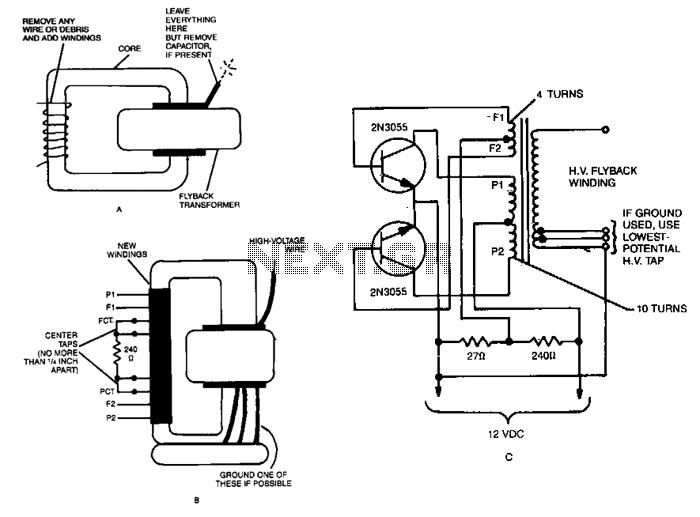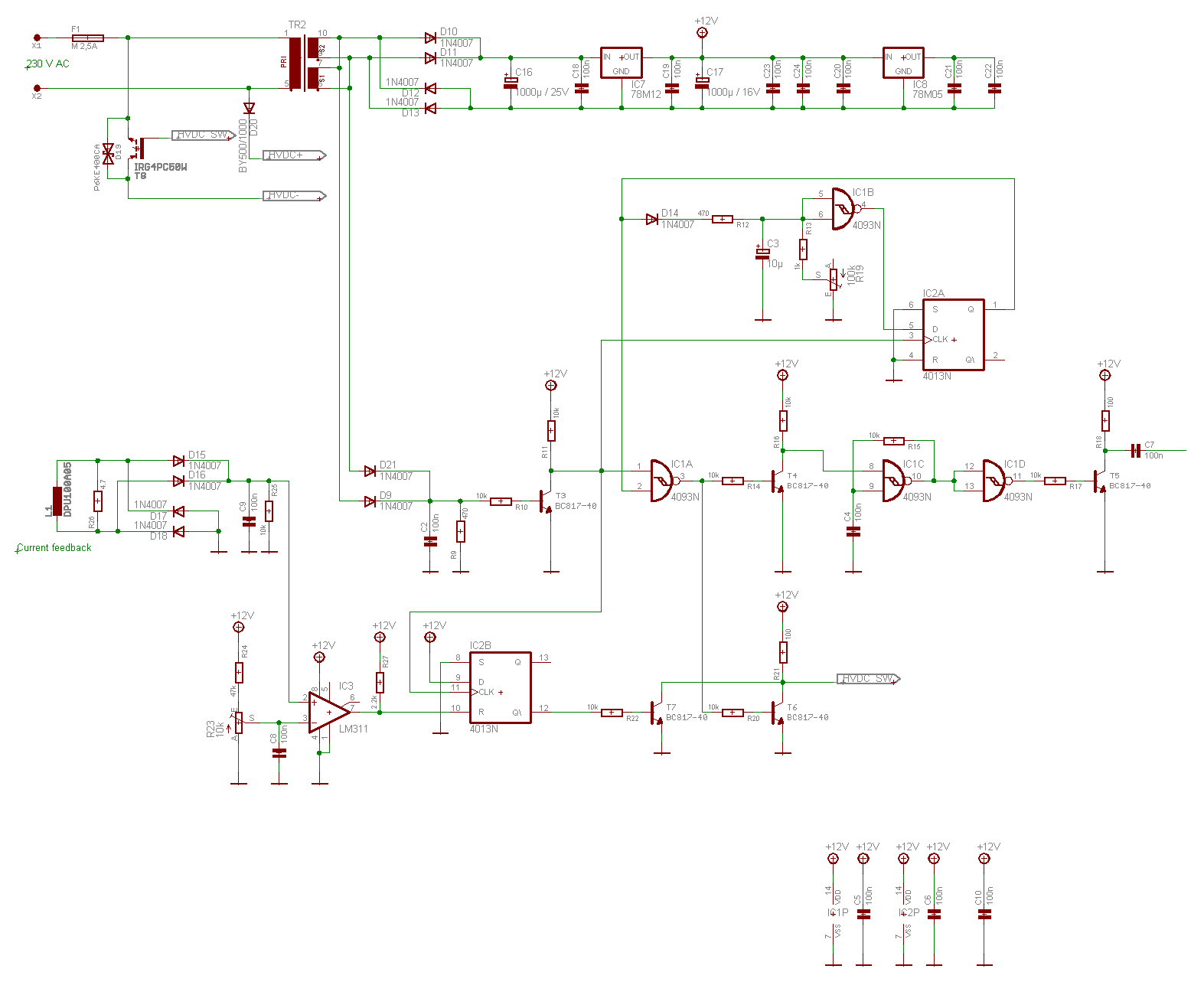
Teslacoil

Power is supplied to transformer T1, a small neon-sign transformer, which steps up the voltage to approximately 3000 Vac. The stepped-up output from T1 is routed through inductors L1 and L2 and across capacitor C1, allowing the capacitor to charge until sufficient energy is stored to create an arc across the spark gap. The spark gap, which temporarily connects C1 and L3 in parallel, regulates the current transferred between C1 and L3. The arcing across the spark gap generates a series of high-voltage pulses through L3, resulting in an oscillating effect. The energy transmitted through L3 is magnetically coupled to coil L1, producing an even higher voltage across U due to the turn ratio between L3 and U. Coil U increases the voltage, which accumulates on the top-capacitance sphere, leading to an avalanche breakdown of the surrounding air and resulting in a luminous discharge. The rotary spark gap serves as an additional circuit for the Tesla Coil, comprising a variable DC power supply and a small 5000-rpm DC motor. This setup allows for the adjustment of the Tesla coil's output by changing the motor's rotational speed. A rotary gap is significantly more efficient than a stationary gap, as the latter may require periodic adjustments due to potential cut-outs.
The described circuit operates on the principles of high-voltage generation and energy transfer through inductive coupling. The initial voltage step-up is achieved by the neon-sign transformer T1, which is designed to handle high voltages typically required for neon lighting. The output voltage of around 3000 Vac is substantial enough to charge capacitor C1, which acts as an energy reservoir. When the voltage across C1 reaches a critical level, the spark gap triggers, allowing current to flow into L3. The inductive components L1 and L2 help shape the waveform of the output, while L3 plays a crucial role in generating high-frequency oscillations.
The magnetic coupling between L3 and coil U is essential for achieving high voltage levels. The design takes advantage of the transformer principle, where the voltage increase is proportional to the turn ratio of the coils. The top-capacitance sphere serves as an electrode, and when the voltage is sufficiently high, the air around it ionizes, resulting in a visible discharge.
The inclusion of a rotary spark gap enhances the performance of the Tesla Coil by allowing continuous operation and reducing the need for manual adjustments. The variable DC power supply enables fine-tuning of the motor's speed, which directly influences the frequency of the discharges produced by the spark gap. This adaptability is crucial for optimizing the output characteristics of the Tesla Coil, making it suitable for various applications, including demonstrations of high-voltage phenomena and experiments in wireless power transmission. Overall, this circuit exemplifies the intricate interplay of components in generating and manipulating high-voltage electrical discharges.Power is fed to transformer Tl, a small neon-sign transformer, which steps the voltage up to about 3000 Vac. The stepped-up output of Tl is fed through L1 and L2 and across Cl, causing the capacitor to charge until enough power is stored in the unit to produce an arc across the spark gap.
The spark gap, which momentarily connects Cl and L3 in parallel, determines the amount of current transferred between Cl and L3. The arcing across the spark gap sends a series of high-voltage pulses through L3, giving a sort of oscillated effect. The energy fed through L3 is transferred to lA via the magnetic coupling between the two coils. Because of the turn ratio that exists between L3 and U, an even higher voltage is produced across U.
Coil U steps up the voltage, which collects on the top-capacitance sphere. There, it causes an avalanche breakdown of the surrounding air, giving off a luminous discharge. The rotary spark gap is a simple add-on circuit for the Tesla Coil, consistiug of a variable de power supply and a small, 5000-rpm, de motor. The circuit allows you to vary the output of the Tesla coil by adjustiug the rotatiug speed of the motor.
A rotary gap is far more efficient than a stationary gap, because the stationary gap could cut-out and require readjustment.
The described circuit operates on the principles of high-voltage generation and energy transfer through inductive coupling. The initial voltage step-up is achieved by the neon-sign transformer T1, which is designed to handle high voltages typically required for neon lighting. The output voltage of around 3000 Vac is substantial enough to charge capacitor C1, which acts as an energy reservoir. When the voltage across C1 reaches a critical level, the spark gap triggers, allowing current to flow into L3. The inductive components L1 and L2 help shape the waveform of the output, while L3 plays a crucial role in generating high-frequency oscillations.
The magnetic coupling between L3 and coil U is essential for achieving high voltage levels. The design takes advantage of the transformer principle, where the voltage increase is proportional to the turn ratio of the coils. The top-capacitance sphere serves as an electrode, and when the voltage is sufficiently high, the air around it ionizes, resulting in a visible discharge.
The inclusion of a rotary spark gap enhances the performance of the Tesla Coil by allowing continuous operation and reducing the need for manual adjustments. The variable DC power supply enables fine-tuning of the motor's speed, which directly influences the frequency of the discharges produced by the spark gap. This adaptability is crucial for optimizing the output characteristics of the Tesla Coil, making it suitable for various applications, including demonstrations of high-voltage phenomena and experiments in wireless power transmission. Overall, this circuit exemplifies the intricate interplay of components in generating and manipulating high-voltage electrical discharges.Power is fed to transformer Tl, a small neon-sign transformer, which steps the voltage up to about 3000 Vac. The stepped-up output of Tl is fed through L1 and L2 and across Cl, causing the capacitor to charge until enough power is stored in the unit to produce an arc across the spark gap.
The spark gap, which momentarily connects Cl and L3 in parallel, determines the amount of current transferred between Cl and L3. The arcing across the spark gap sends a series of high-voltage pulses through L3, giving a sort of oscillated effect. The energy fed through L3 is transferred to lA via the magnetic coupling between the two coils. Because of the turn ratio that exists between L3 and U, an even higher voltage is produced across U.
Coil U steps up the voltage, which collects on the top-capacitance sphere. There, it causes an avalanche breakdown of the surrounding air, giving off a luminous discharge. The rotary spark gap is a simple add-on circuit for the Tesla Coil, consistiug of a variable de power supply and a small, 5000-rpm, de motor. The circuit allows you to vary the output of the Tesla coil by adjustiug the rotatiug speed of the motor.
A rotary gap is far more efficient than a stationary gap, because the stationary gap could cut-out and require readjustment.
